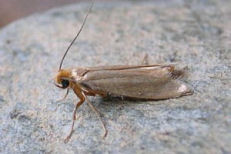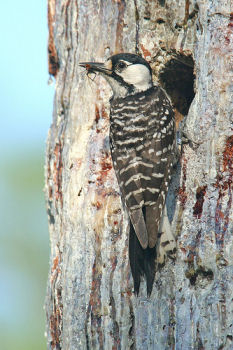Over millions of years, cedar developed an impressive chemical arsenal to fend off insects, disease and decay. Some of these compounds are potentially toxic to humans, but are they harming birds that nest in cedar boxes? Some say yes. Because there are no studies to prove this one way or another, we are left to conduct our own research, or to listen to others, or both, then form our own conclusions.
Cedar Nestboxes
by Fred Stille
by Fred Stille



Cedar The Moth Killer
....seriously?
....seriously?
The smoking gun
In the mid 1980's the Occupational Health and Safety Administration (OSHA), published a report linking Western Red Cedar dust to various respiratory problems, including asthma, in 3 to 14 percent of exposed sawmill workers. OSHA identified cedar's primary irritant, Plicatic Acid, to be the cause of these ailments. When this information filtered into the birding community, it triggered the alarm bells. "If Plicatic acid is doing this to humans, imagine what it's doing to birds in a cedar nestbox!" Unfortunately, this false logic stuck. Plicatic Acid (PA) became the "smoking gun" in discussions concerning the dangers of cedar nestboxes. Add this to cedar's infamous reputation as a moth killer (see sidebar article), and the king of nestbox woods suddenly found itself on trial.
The dose makes the poison
To understand whether a potentially toxic substance will produce harmful effects, we must determine how that substance reaches a susceptible biological system within the body, and in what concentrations. In short, determine the dose.
Because PA is a non volatile compound, it does not evaporate into the atmosphere. Cedar does not emit PA, nor does PA "ooze" from the wood. The only way this toxin can become airborne is aboard sawdust created when the wood is machined. Otherwise, it stays locked inside the wood's fibers and essential oils. In the case of woodworkers exposed to cedar dust, the dose of PA enters the body via inhalation of that dust. In a nestbox environment there are no clouds of sawdust, and since birds don't eat their nestbox, it is therefore impossible for the birds to receive even a small dose of PA. The verdict? For the woodworkers who machine cedar, Plicatic Acid is a potential health threat. For birds in a cedar nestbox, PA is not even a factor. Not Guilty.
Cedar's Aromatic Hydrocarbons
But cedar is not completely off the hook, not yet. In addition to PA, Western Red Cedar contains at least nine other compounds. Most notable are the hydrocarbons Thujaplicin (decay resistance), Thujaplicinol (primary aroma), and Phenol. It is important to note that today's cedar, cut from younger trees, has far less concentrations of these hydrocarbons as compared to the old growth trees harvested fifty years ago.
Unlike PA, these compounds are volatile, meaning they do evaporate into the atmosphere. Emissions of these hydrocarbons are at their strongest when the wood is freshly milled. But this evaporation is rapid and short lived. After the logs are cut into boards, the finished lumber is sent to either drying racks or to kilns. By the time the wood completes the drying process and reaches a distributor, emissions have dramatically abated. Western Red Cedar boards at retail stores often have little aroma, an indication of minimal hydrocarbon emission.
The openings in a nestbox - the entry, door seams and vents - provide a constant air exchange within the box. Any residual hydrocarbon emissions are therefore being constantly expelled, but in a nestbox made of fresh, new cedar, there is no argument that the birds are inhaling these compounds in some concentration. To understand whether this is harming them, we'll turn to a particular bird for advice.
The Red Cockaded Woodpecker prefers to make its home in living long leaf pine. So what does pine have to do with cedar? Pines share many of the same volatile compounds as cedar, including phenol.
As this woodpecker chisels its cavity, it is constantly exposed to the hydrocarbons released from the excavation process. Would not a bird's instincts warn it if it were nesting in a toxic environment? It is logical to assume, therefore, that the volatile hydrocarbons have no adverse effects on the bird.
Conclusion
The lack of research into this matter is very easily explained - none is needed. We are not finding sick or dying birds in cedar boxes. As far as unseen, long term harm, evidence would have surfaced by now; we have been using cedar as our primary nestbox wood for over six decades. Bluebird populations in particular have risen dramatically over that same period, and woodpeckers have been hammering out cavities and raising young in cedar trees for millions of years.
In the mid 1980's the Occupational Health and Safety Administration (OSHA), published a report linking Western Red Cedar dust to various respiratory problems, including asthma, in 3 to 14 percent of exposed sawmill workers. OSHA identified cedar's primary irritant, Plicatic Acid, to be the cause of these ailments. When this information filtered into the birding community, it triggered the alarm bells. "If Plicatic acid is doing this to humans, imagine what it's doing to birds in a cedar nestbox!" Unfortunately, this false logic stuck. Plicatic Acid (PA) became the "smoking gun" in discussions concerning the dangers of cedar nestboxes. Add this to cedar's infamous reputation as a moth killer (see sidebar article), and the king of nestbox woods suddenly found itself on trial.
The dose makes the poison
To understand whether a potentially toxic substance will produce harmful effects, we must determine how that substance reaches a susceptible biological system within the body, and in what concentrations. In short, determine the dose.
Because PA is a non volatile compound, it does not evaporate into the atmosphere. Cedar does not emit PA, nor does PA "ooze" from the wood. The only way this toxin can become airborne is aboard sawdust created when the wood is machined. Otherwise, it stays locked inside the wood's fibers and essential oils. In the case of woodworkers exposed to cedar dust, the dose of PA enters the body via inhalation of that dust. In a nestbox environment there are no clouds of sawdust, and since birds don't eat their nestbox, it is therefore impossible for the birds to receive even a small dose of PA. The verdict? For the woodworkers who machine cedar, Plicatic Acid is a potential health threat. For birds in a cedar nestbox, PA is not even a factor. Not Guilty.
Cedar's Aromatic Hydrocarbons
But cedar is not completely off the hook, not yet. In addition to PA, Western Red Cedar contains at least nine other compounds. Most notable are the hydrocarbons Thujaplicin (decay resistance), Thujaplicinol (primary aroma), and Phenol. It is important to note that today's cedar, cut from younger trees, has far less concentrations of these hydrocarbons as compared to the old growth trees harvested fifty years ago.
Unlike PA, these compounds are volatile, meaning they do evaporate into the atmosphere. Emissions of these hydrocarbons are at their strongest when the wood is freshly milled. But this evaporation is rapid and short lived. After the logs are cut into boards, the finished lumber is sent to either drying racks or to kilns. By the time the wood completes the drying process and reaches a distributor, emissions have dramatically abated. Western Red Cedar boards at retail stores often have little aroma, an indication of minimal hydrocarbon emission.
The openings in a nestbox - the entry, door seams and vents - provide a constant air exchange within the box. Any residual hydrocarbon emissions are therefore being constantly expelled, but in a nestbox made of fresh, new cedar, there is no argument that the birds are inhaling these compounds in some concentration. To understand whether this is harming them, we'll turn to a particular bird for advice.
The Red Cockaded Woodpecker prefers to make its home in living long leaf pine. So what does pine have to do with cedar? Pines share many of the same volatile compounds as cedar, including phenol.
As this woodpecker chisels its cavity, it is constantly exposed to the hydrocarbons released from the excavation process. Would not a bird's instincts warn it if it were nesting in a toxic environment? It is logical to assume, therefore, that the volatile hydrocarbons have no adverse effects on the bird.
Conclusion
The lack of research into this matter is very easily explained - none is needed. We are not finding sick or dying birds in cedar boxes. As far as unseen, long term harm, evidence would have surfaced by now; we have been using cedar as our primary nestbox wood for over six decades. Bluebird populations in particular have risen dramatically over that same period, and woodpeckers have been hammering out cavities and raising young in cedar trees for millions of years.
Red Cockaded Woodpecker
Home | Site Map | Disclaimer | Contact Us
Copyright © 2012 NestboxBuilder.com
This site was last updated on 01/01/2016
Copyright © 2012 NestboxBuilder.com
This site was last updated on 01/01/2016


Nestbox photo by David Kinneer
Despite it's reputation to the contrary, cedar does not kill the clothes moth. The fine woolens stored in your cedar chest or cedar-lined closet might escape damage wreaked by clothes moth larvae, but for a very different reason.
Scientists now believe that evaporation of cedar's aromatic hydrocarbons mask the scent of fabrics, so the moth simply passes by unaware. These hydrocarbons also confuse receptors in insects, which they find a bit alarming. Unfortunately, the emissions of cedar's hydrocarbons in sufficient quantities to mask fabric scent are short lived.
An old cedar chest will not protect your clothes from moths. One study suggested that a cedar chest more than three years old is useless in masking the scent of the fabrics inside. Having a storage chest that is tightly constructed is more important in keeping clothes moths out than whether or not the chest is made of cedar.
The effectiveness of cedar-lined closets and cedar chests is generally overstated. Not that cedar doesn't work, it just doesn't work well or for very long. Because closets cannot be as tightly constructed as the cedar chest, moths can easily enter once cedar's hydrocarbon emissions have abated.
Scientists now believe that evaporation of cedar's aromatic hydrocarbons mask the scent of fabrics, so the moth simply passes by unaware. These hydrocarbons also confuse receptors in insects, which they find a bit alarming. Unfortunately, the emissions of cedar's hydrocarbons in sufficient quantities to mask fabric scent are short lived.
An old cedar chest will not protect your clothes from moths. One study suggested that a cedar chest more than three years old is useless in masking the scent of the fabrics inside. Having a storage chest that is tightly constructed is more important in keeping clothes moths out than whether or not the chest is made of cedar.
The effectiveness of cedar-lined closets and cedar chests is generally overstated. Not that cedar doesn't work, it just doesn't work well or for very long. Because closets cannot be as tightly constructed as the cedar chest, moths can easily enter once cedar's hydrocarbon emissions have abated.

